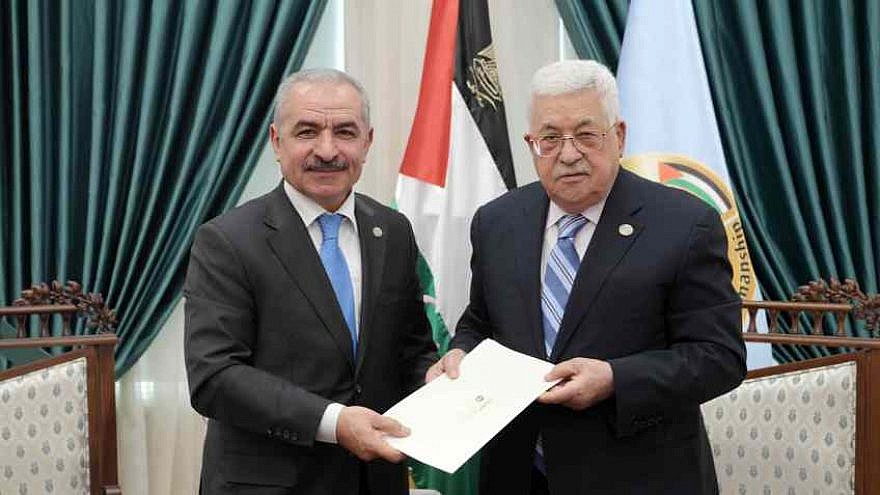Two developments currently taking place in the Palestinian arena deserve our attention, and both of these are interlinked: the proposed new government in Ramallah and the situation at the Al-Aqsa plaza on the Temple Mount.
In Ramallah, P.A. leader Mahmoud Abbas has asked Mohammad Shtayyeh to form a new government, while on the Temple Mount, tensions continue to mount around the Golden Gate or “Gate of Mercy” (Sha’ar HaRachamim or Bab el Rahma).
First, who is Shtayyeh, and what does he stand for?
Like Hamdallah and Salam Fayyad before him, Shtayyeh comes from Nablus and is linked to the business community. Previously, he was president of the Palestinian Economic Council for Development and Reconstruction (PECDAR),1 the leading economic institute in the Palestinian Authority. Unlike his predecessors, he is a senior Fatah official in the West Bank.
He is a promoter of the BDS movement, in favor of ending security coordination with the Israel Defense Forces and seeks to end the Paris Protocols that refer to a joint economy with Israel.
It is interesting to watch the extent to which these popular campaigns inside Fatah may reflect real life.
The Nablus connection
Shtayyeh’s appointment indicates that the P.A. follows a tradition of nominating its prime ministers from Nablus to avoid alienating the north from its main body, which is centered in Ramallah.
In this respect, Hebron in the south appears to be lost.
According to Ramallah sources, Abbas was in no hurry to implement the decisions of the Fatah Central Committee to nominate a Fatah-controlled government, and he delayed doing so even after Hamdallah submitted his resignation. The timing of the decision came, according to sources, when he heard about progress in the talks in Cairo between Egypt and Hamas.
He therefore wanted to dissolve the government led by Hamdallah to set back any progress in Cairo.
Egypt, Hamas and Fatah
Egypt is not holding contacts with Hamas as a legitimate power, but on an ad hoc basis, and it insists to Hamas that Ramallah is the legal ruling authority. By dissolving the current and recognized Hamdallah government, any progress between Egypt and Hamas is blocked.
It is important to note that Hamas is also not in a hurry to renew its own “Gaza Committee,” which was the actual government in Gaza, and they are waiting to see if a Fatah government will indeed be established in Ramallah.
Why would Hamas have any doubts about this?
Firstly, Shtayyeh is not a Fatah fighter. According to Palestinian criteria, to be considered a true Fatah fighter, one must spend time in an Israeli prison. With Shtayyeh, this is not the case.
At the very least, Shtayyeh may be expected to give Fatah senior officials leading positions in his new government. However, according to an interview he gave to RT, Shtayyeh does not appear to be thinking in this direction.2 Rather than referring to his new administration as a “Fatah government,” he said that it would be “everybody’s government.”
Fatah’s main concern now is that their senior officials be promoted to key positions that will reflect what will happen the “day after” Abbas.
If no Fatah senior figure is promoted in the government, it may mean that after the demise of Abbas, the “private sector” (meaning the business community) will take the reins of power rather than Fatah.
The reason why Abbas is not interested in promoting any of the “real Fatah” seniors is to avoid inflaming the succession struggle now.
Instead of a “Fatah government” as such, Abbas is more interested in a “PLO government” due to his struggle with Hamas over the legitimacy of the PLO’s authority.
While Hamas derives its legitimacy from the 2006-07 elections and the Palestinian Legislative Council, the parliament that was elected then, Abbas wants to solidify the legitimacy of the historic PLO and to make it the legitimate source of the proposed new government.
Siding with ‘terrorist’ organizations?
But here lies the main problem, which is the inability of the P.A. chief to make the main compromise in forming this government.
The leading PLO organizations, including the Popular Front, the Democratic Front and Islamic Jihad, are aligned with Hamas rather than Ramallah. It is now taken for granted that they will not join Shtayyeh’s new government, but will instead stay with the Hamas War Chamber.
It is expected that Shtayyeh will “open the door” to those organizations, which are “terrorist” according to every definition, thereby putting the continuation of world financial aid to Ramallah at risk.
Only tiny organizations, such as the once pro-Saddam Arab Front, are aligned with Abbas through financial subsidies, of course.
All of the above is linked to the Jerusalem issue. Ramallah wants to make to fight for Jerusalem the leading national struggle, while for Hamas, the central battle is along the borders. Abbas’s aim is to attract the PLO organizations to join Ramallah at the expense of Gaza.
* * *
Notes:

























